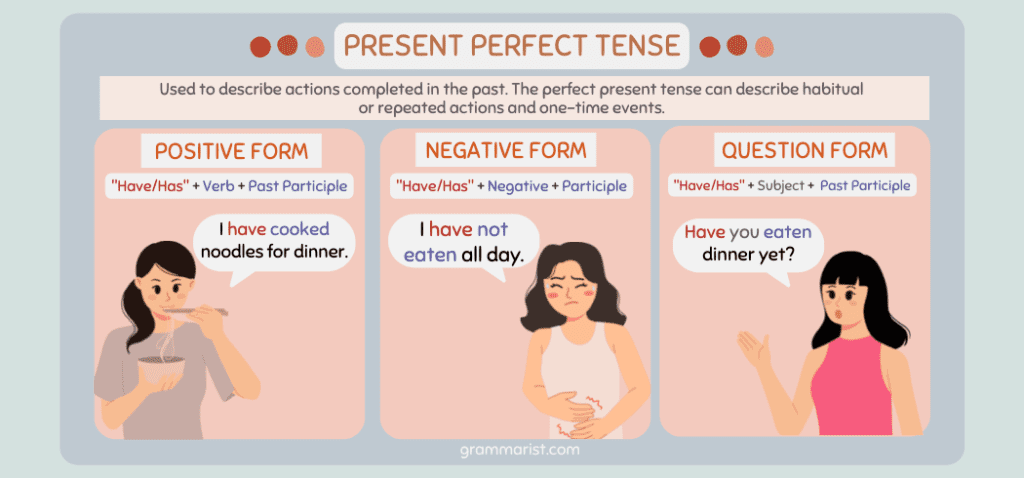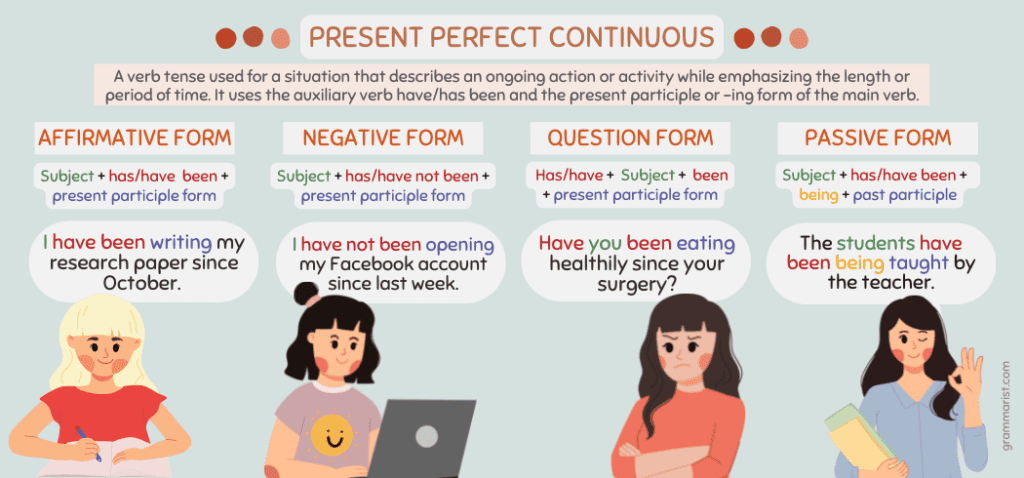Have you eaten sweets your whole life, or have you been eating sweets your whole life? I know, what’s the difference, right? It’s minor and hard to miss, but there’s actually a big difference between those two statements. This grammar issue is common among many English writers.
Let’s discuss the differences found between present perfect and present perfect continuous tenses. I’ll even show you their different functions, formulas, and examples of how to use them in sentences.
After reading my article, you can also answer the multiple-choice exercise with answers.
What is the Present Perfect Tense?

In English grammar, the present perfect or present perfect simple tense is a verb tense showing an action whose completion occurred at an unknown time in the past. We can also use it for actions that happened in the past with an effect in the present or has a connection to the present and future.
A sentence with a verb phrase in the present perfect tense follows this formula:
- Subject + has/have + past participle form of verb.
Negative sentences follow this formula:
- Subject + has/have not + past participle form of verb.
Interrogative sentences follow this structure:
- Has/have + subject + past participle form of verb?
Most regular verbs end in -d or -ed for their past participle forms. But some past participle forms do not follow this pattern because they are irregular verbs.
Below are some examples of sentences with present perfect verbs.
- She has sent the email.
- I have written you a letter.
- Mary has not yet received the money in her account.
- Have you gone to the UK?
What is the Present Perfect Continuous Tense?

The present perfect continuous (or present perfect progressive) tense describes a moment in time that started in the past and is continuing at present.
A verb in the present perfect continuous form follows this sentence formula:
- Subject + has/have been + present participle form of verb.
Negative sentences follow this formula:
- Subject + has/have not been + present participle form of verb.
Lastly, interrogative sentences follow this structure:
- Has/have + subject + been + present participle + time frame?
Here are some sentence examples.
- We’ve been answering mixed exercises since last week.
- The teacher has been preparing the learning activity in the grammar book for five days.
- John has not been eating fruits for one year.
- Has he been living in the United States since 2020?
- Have the children been playing for one hour?
- Has she not been living here since last year?
What’s the Difference?
The present perfect and present perfect continuous tenses have differences in meaning and rules. Let’s discuss them one by one.
Short-Term or Long-Term Action
In most cases, we can choose either of the tenses with since and for as time references to show the time frame of the action.
But we use the present perfect continuous to show emphasis on the activity happening over a period of time that’s short-term. But for long-term ongoing actions, use the present perfect tense. Here’s an example of an original sentence.
- I’ve been cooking.
This sentence might make you ask, how much did the speaker put time into cooking? Since it uses the present perfect continuous tense, it implies that it’s only short-term.
Here are more sentence examples.
- I’ve played badminton since I was a kid. (long-term)
- I’ve been playing badminton since this afternoon. (short-term)
Continuing or Completed Action
The present perfect tense places emphasis on the completion of an action in the recent past. In fact, the basic meaning of this verb tense is based on a sense of completion. Meanwhile, the present continuous tense shows that it is not yet completed. Here’s a sample sentence.
- I’ve read a book about religion.
This sentence means that the speaker has finished the book. Below is another example.
- We’ve been answering the online exercises.
This example means the speaker has not yet finished answering the online exercises.
Repeated or Single Action
You can use the present perfect continuous form for repeated action. This sole sentence is a good example.
- The grammar wiz in our class has been giving tutorials.
In this sentence, the grammar wiz may have tutored several times already.
Here are more examples:
- The professor has been sending the lessons by email newsletter. (shows that the professor has sent lessons many times)
- The professor has sent the lessons by email newsletter. (could just be once)
- Your husband has called you. (could be once)
- Your husband has been calling you. (could have happened many times)
Stative Verbs or Sense Verbs
Do not use the continuous form with verbs of state or mental processes. Unlike action verbs, a stative or non-continuous verb expresses a state or condition instead of action. Some examples include thinking, understanding, believing, knowing, and seeing. Also, we don’t use the present continuous tense with verbs of the senses, such as smell, hear, and taste.
Examples:
Wrong: We have been knowing each other for a very long time.
Correct: We have known each other for a very long time.
Wrong: I have been hearing the news.
Correct: I have heard the news.
When discussing durations of ongoing activities using stative verbs, we use the present perfect simple tense. But for ongoing activities with active verbs, we use the present perfect progressive form. For example:
- I’ve been a doctor for five years.
- I’ve been treating cancer for five years.
Reviewing the Present Perfect and Present Perfect Continuous Tenses
I hope my guide has taught you the difference between the present perfect and present perfect continuous tenses. I put together some key points to remember:
- Use the present perfect tense for long-term actions and the present perfect continuous tense for short-term actions.
- Use the present perfect tense for completed action and the present perfect continuous tense for ongoing actions.
- Use the present perfect form to discuss states instead of actions with verbs like think, know, seem, and have.